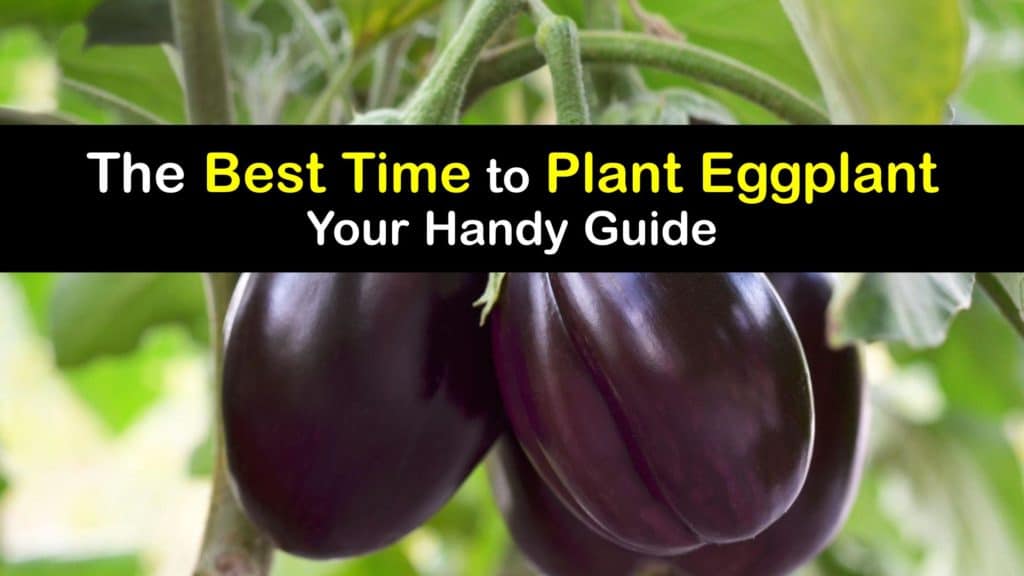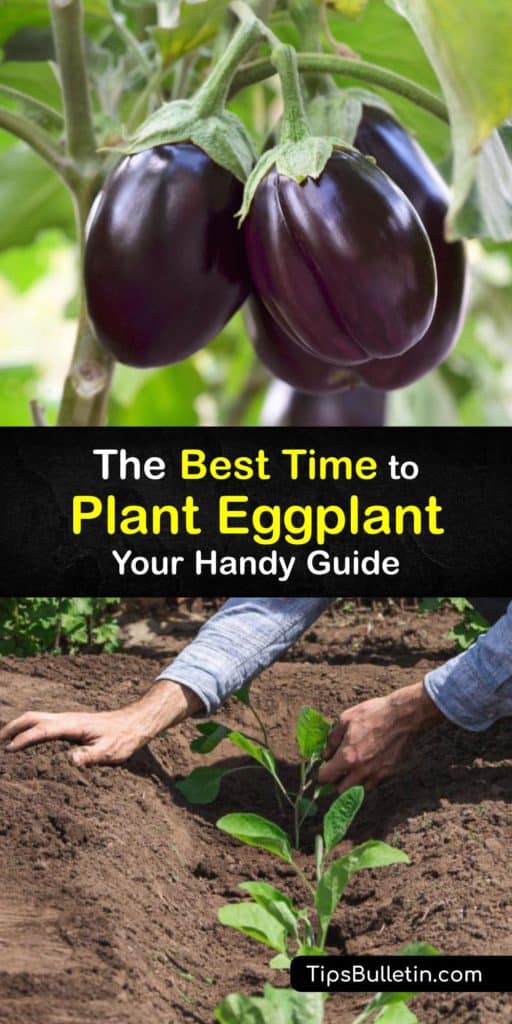This season, it’s all about eggplant. Whether you’re interested in growing eggplant as a food source or cultivating ornamental containers, we’ve got your questions covered. Learn when to plant eggplant according to your hardiness zone and helpful tips about companion plants and common pests.
Eggplant is an ancient and exciting vegetable; genetic studies show a botanical history that stretches back over 2 million years. Eggplants are a Solanaceae family member, and we also refer to them as nightshades.
This family includes herbs, vines, and even shrubs. You likely know some of the more famous agricultural staples like bell pepper, tomato, and eggplant. Solanum melongena, or the eggplant, is classified as a berry because it has edible seeds that grow from the single bud of a flowering plant. They prefer warm weather and consistently moist soil to mature those big, shiny eggplant “berries.”

A Bit about Eggplant Growing Season
It may seem a little intimidating in the beginning, but with these helpful hints, your garden will be full of fantastic eggplant plants before you know it. Eggplant growing season is upon us, and it’s time to learn when to plant eggplant seeds, what to plant them with, and a delicious recipe for the eggplant fruit harvest.
When to Plant Eggplant Seeds
Eggplant thrives in tropical and subtropical areas of Asia and is considered a perennial in warmer climates. However, in North America, we typically grow eggplant as an annual crop because the soil temperature dips so much in the colder months.
Every eggplant variety is considered frost tender, so your plan for when to plant eggplant seeds should be based on the last advised frost date.
Eggplant seeds are available from your local nursery or online. There are quite a few unique eggplants, but they are all full sun-loving, warm-weather plants. If you want a grocery store purple eggplant, grow Black Beauty, one of the most common types of eggplant you can buy.
Japanese eggplant cultivars like Ichiban or Shikou are long and thin and noted for their mild flavor. Varieties like Easter Egg or Fairy Tale are charming mini versions that fit right in the palm of your hand. Eggplant can be enormous or adorable, depending on your needs.
The best time to plant eggplant seeds is eight to ten weeks before the last frost. Fill a sterilized seed container with rich potting soil and suitable organic matter. Make holes ¼ inch deep, pop the tiny seeds in, and cover lightly with soil. Give them a good drink and keep the soil moisture consistent throughout the germination process, which takes about three weeks.

As temperatures warm outside, get the eggplant seedlings ready for life outdoors by placing them in a colder space and giving them less water. The “hardening off” process helps build stronger eggplants to withstand life in your home garden better.
When to Plant Eggplant in the Garden
Your eggplant growing season does depend on the local climate or hardiness zone. The USDA has a handy climate map that helps determine the best time to plant outdoors by showing the expected lowest temperature for your hardiness zone.
Eggplants are at their best in warm weather, with stable temperatures between 70 and 85°F, so they are perfect veggies to plant in summer in most locations. As a general rule, eggplants are hardy in zones 5 to 12 and prefer 6 to 8 hours of full sun every day.
Container planting eggplant is very popular and works well for anyone with a short growing season, limited space, or unsuitable soil. The best time to plant eggplant in containers depends on your local climate, but starting eggplant from seed indoors is usually successful 8 to 10 weeks before you plan to send them outside.
Transplant them into a 5-gallon container using well-draining soil with a pH of 5.8 to 6.5 and top with organic mulch. Keep the soil moist. Fertilizing eggplants is an important part of the growing process. Use a homemade fertilizer for eggplant or give your young plant a balanced 10-10-10 fertilizer every 3 weeks.
When to Plant Eggplant in Zone 5
Hardiness zone 5 has a shorter growing season than some other zones. The last frost date is usually mid-May, with the first in mid-October.
Gardeners across 32 states need to be wary of minimum temperatures of -15°F and unexpected frost warnings while planning when to plant eggplant in zone 5. Always consult your local weather and long-term almanac when making your transplanting timetable.
When to Plant Eggplant in Zone 6
Hardiness zone 6 has yearly projected average low temperatures of -10°F. Zone 6 runs through 38 states and covers some very diverse topography.
Choosing when to plant eggplant in zone 6 is somewhat flexible if you start the eggplant seeds indoors and wait until the outdoor temperatures are consistently 70°F and above. The growing season is medium length and begins from the last frost in early April to the first frosts of late October.
When to Plant Eggplant in Zone 7
Hardiness zone 7 covers 28 states and has a yearly projected low average of 5°F. Despite some weather unpredictability, there are a variety of fruit trees, berries, and nuts that grow successfully in zone 7, right along with the eggplant.
The last predicted frost is usually mid-April, though dates for when to plant eggplant in zone 7 will be a game-time decision as frosts are known to arrive as late as May.
When to Plant Eggplant in Zone 8
Hardiness zone 8 spans 20 states and boasts a yearly projected average low temperature of 10°F. The first frosts begin in mid-October, with the last frost usually late in March.
There’s a lot of freedom regarding when to plant eggplant in zone 8. There are as many options for what to grow with your eggplant. Herbs, tender peppers, and beautiful fruit trees thrive in zone 8.
Companion Planting Eggplant
Like many plants, eggplant does a bit better with a few friends. Companion planting brings beneficial insects, enriches the soil, and adds much-needed biodiversity to city gardens. Other nightshade family members are complementary, like the cherry tomato, potato, and bell pepper plants.
However, too many plants from the same family attract the same pests. Add aromatic herbs like thyme, oregano, and French tarragon to draw away flea beetles and boost your pantry.
Grow flowers like marigold and nasturtium, and add members of the mint family like spearmint and peppermint for what to grow with eggplant. There are plenty of beneficial plants out there no matter what your gardening style may be.
Common Eggplant Pests
Eggplant fruit is ready for harvest in about 60 days, but in the meantime, you must protect it from hungry garden invaders and fungal infections. The flea beetle and Colorado potato beetle are common pests, as is the tomato hornworm.
Non-toxic Pyrethrin spray directly on the leaf works against all three invasive bugs. Many gardeners recommend laying black plastic mulch for large outdoor areas to keep pest numbers down. Plastic mulch also keeps the soil temperature up and reduces the need for regular weeding.
Another concern many gardeners have to contend with is a common fungal infection called verticillium wilt. It kills the leaves and stubbornly hangs around in the soil, even after the infected plant is gone.
Choose resistant eggplant varieties and watch for yellowed leaves to combat this tricky disease. If you face a verticillium wilt infection, find a suitable organic fungicide, and prepare yourself for crop rotation.
Although it’s not required, pruning eggplant often yields larger, tastier fruit.
Excellent Eggplant Parmesan Recipe
After growing your eggplant, you may wonder the ideal time to pick eggplant and what to do with it after harvesting. It’s likely that Eggplant Parmesan is one of the most popular eggplant dishes.
The eggplant came to Italy in the 15th century by way of India, and the Italians took this interesting new ingredient and ran with it.
There are historical recipes for Eggplant Parmesan going back to at least 1839 and some even earlier versions showing the evolution of this popular dish. We hope your friends and family enjoy this easy-to-make recipe.
Make sure the oven is ready to go by preheating it to 400°F. Use the melted butter to grease an 11 x 7-inch baking dish and set it aside for later use. Peel the eggplant and cut it into ¾ inch slices. Combine the crushed Corn Flakes, salt, pepper, and parmesan cheese in a bowl.
Get a second bowl and crack the egg into it. Dip each eggplant slice in the egg and then into the crumb mixture. Ensure the eggplant is coated on all sides. Place each piece into your already-greased baking dish in single or multiple eggplant layers.
Once all the slices are coated and evenly crumbed, it’s time to cook. Pop your prepped eggplant into the oven and bake for about 20 minutes. Carefully flip all the slices, and bake for an additional 15 minutes.
For the final and most delicious step, pour the marinara sauce over the eggplant, top with mozzarella, and bake for five more minutes until the cheese is gooey and delicious. This easy eggplant favorite serves two to three people and is easily multiplied for more dinner guests.
Eggplant is a versatile, delicious, and rewarding crop. The plentiful harvest adds to any meal as a side dish and truly performs as the star of the show in vegetarian lasagna or Eggplant Parmesan; eggplant even pickles well.
Eggplant seeds and seedlings are available in many varieties; Italian eggplant, Japanese eggplant, globe eggplant, white eggplant, and more. We also can’t forget the interesting ornamental eggplant varieties, which add charm and a conversation point to every garden.
With a bit of information about your local hardiness zone and some helpful tips for when to plant eggplant, you’re well on the way to a very successful growing season and bountiful harvest.
Don’t be afraid to dream big and try anything you find interesting. Gardens are made to provide nutrition and bring a feeling of renewal and joy. We hope you’re excited to grow big this season and plant the eggplant of your dreams.

If you loved learning when to plant eggplant in your garden, share this article with a friend on Facebook or Pinterest who wants to try growing gorgeous eggplant this season.